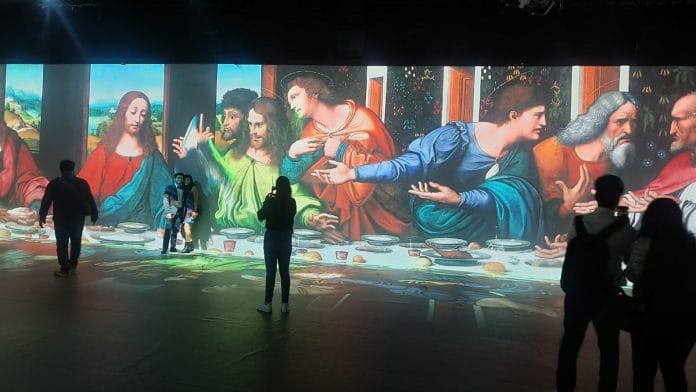Mumbai: Leonardo da Vinci’s works have been endlessly studied, celebrated, and even turned into memes. Now, they’ve had a full-blown digital makeover. Visitors can chat with an AI Mona Lisa, dance with the Vitruvian Man, and set war machines in motion at an immersive Mumbai exhibition that turns his world into a digital, Instagram-friendly playground.
After successful stints in Berlin, Amsterdam, and Florida, the show Da Vinci Genius arrived in India last week, making its debut at NESCO Centre in Goregaon, Mumbai. It brings the Renaissance master’s art, inventions, and ideas to life through projections, AI, and hands-on displays.
Running until 2 March , it features seven screenings a day inside the venue’s parking lot. The experience begins with an 11-minute introductory film by Simply Explained, before drawing visitors into an interactive spectacle featuring over 50 of Da Vinci’s artworks, inventions, and anatomical studies.
Visitors step into a dark hall where a 30-foot-high LED cube glows at the centre of the 46-minute immersive experience, set to an orchestral-electronic soundtrack by DJ Sasha. The pixilating LED cube morphs into the face of Leonardo da Vinci as a voice-over declares: “As an artist, you must go radical, be a mystic, be a legend, challenge, aspire, and go beyond.”
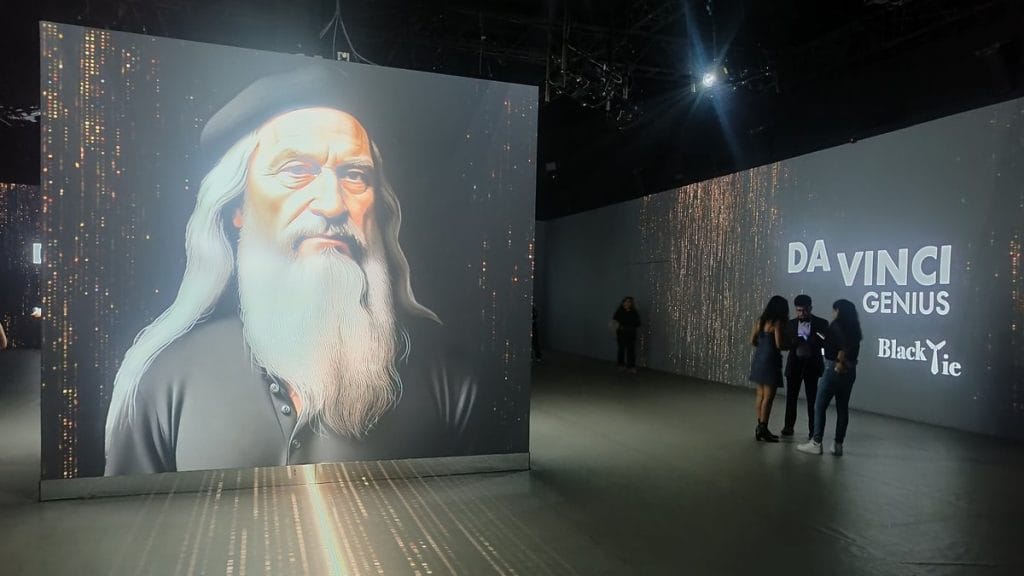
Da Vinci’s drawings light up the walls, mobile phones spring out to capture the moment, and staff encourage visitors to touch the projections, triggering bursts of colour. Some seize the Instagram moment and pose for angel-wing silhouettes against the illuminated walls.
One of the exhibition’s more surreal moments is the Mona Lisa speaking back. A QR code scan on the phone opens a chatbot window, allowing visitors to interact with an AI-generated version of the world’s most famous portrait. But not many attempted this interaction. Most visitors were more interested in taking selfies with her larger-than-life projection. Those who do engage with the AI Mona Lisa are left pondering her searching questions about life and art.
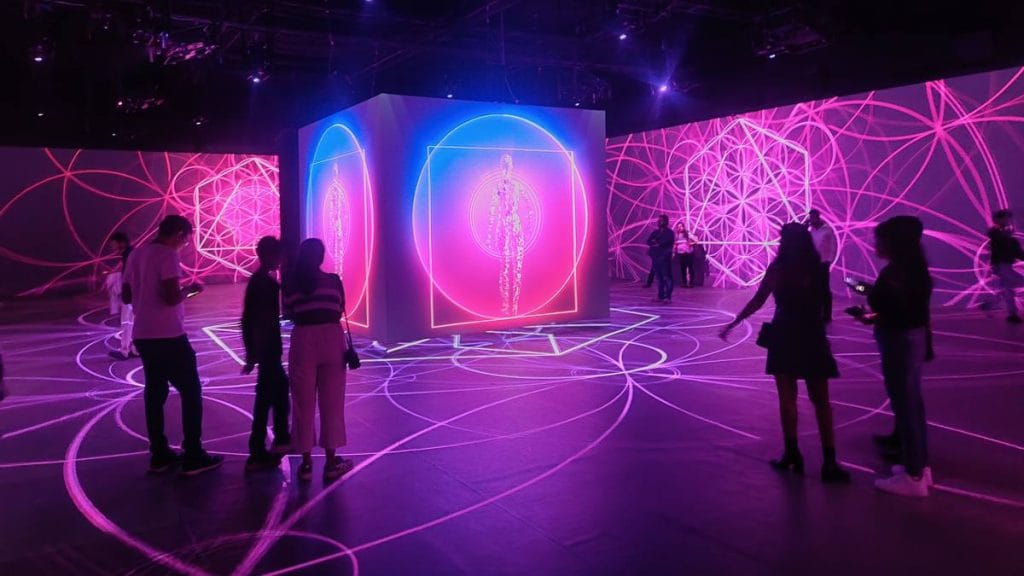
Chatbot Mona Lisa begins with: “Hello there! I’m Mona Lisa, once a painted lady, now a conversational companion. Have you ever thought about the impact of art on society?”
The Vitruvian Man gets a digital upgrade too. At one point, he even shakes a leg on screen, with many in the crowd mimicking his dance moves.
Interactive touchscreen walls also let visitors play with Da Vinci’s war machine designs—tanks, cannons, pinballs, catapults, and aerial screws. A flick of the wrist sends a propeller soaring, pinballs bounce against the walls, and the catapult launches a ball into the air.
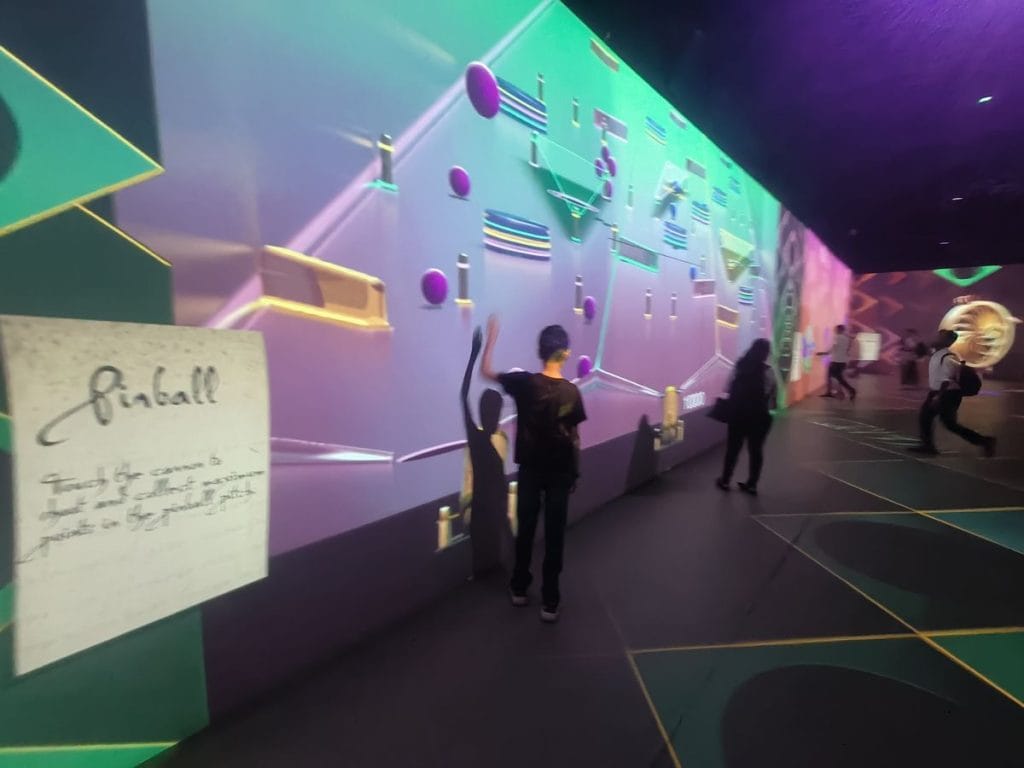
For Kolkata-based Akash Rungta, who was visiting his fiancée in Mumbai, the chance to “make photo memories” was the highlight.
“The interactive part is most fun. It would be boring to stand and observe,” said Rungta, who has studied in Milan and has visited The Last Supper in the city and also seen Mona Lisa at the Louvre.
But for Drishya Poddar, a hairstylist from Juhu, the experience came across as surface-level. She’d expected a deeper dive into Da Vinci’s work.
“I was looking forward to understanding his inventions and paintings better but the focus was more on lights and effects,” said Poddar.
Created by London-based Phoenix Immersive and brought to India by Theia Enterprise, the exhibition will travel to Bengaluru at the end of March, with more shows to be added. Tickets are available on BookMyShow.
Also Read: Roses, dava khana—artist Seema Kohli rebuilds her ‘Pind’ in Pakistan through new exhibition
Spectacle vs substance
Among the many lesser-known facts about Leonardo da Vinci, an oddly reassuring one is that the 15th-century draftsman, sculptor, painter, scientist, and innovator was a procrastinator. His perfectionism and constant pursuit of new ideas often left projects unfinished. The Last Supper, for instance, took three years to complete, as Da Vinci experimented with techniques that pushed the limits of perspective and composition.
At Da Vinci Genius, The Last Supper stretches across the walls, pulling viewers into its details. The exhibit breaks down how Da Vinci applied linear perspective, with a single vanishing point drawing the eye directly to Jesus’ right temple. The masterpiece has inspired music, science, and mathematical explorations, and even led to a theory linking each of the 12 apostles to astrological signs.
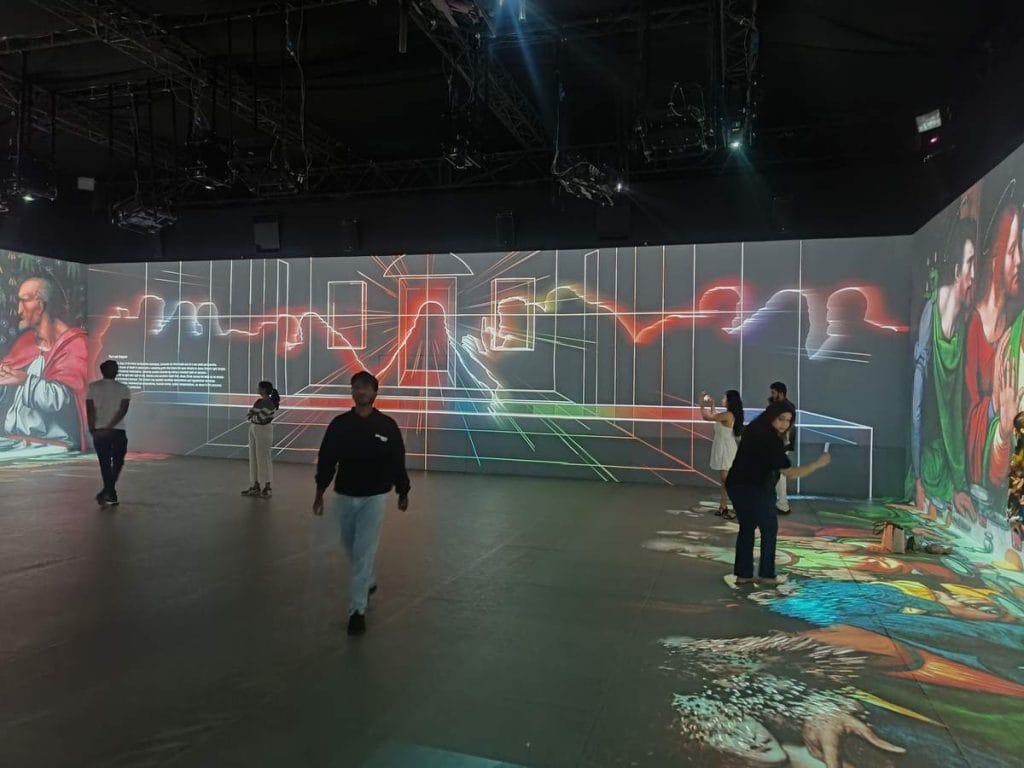
Throughout the exhibition, an AI-generated voice-over reflects Da Vinci’s thoughts on nature, art, and science. The creators, however, have taken artistic liberties, placing Da Vinci in modern setting with visual art inspired by his works.
Mumbai has seen immersive art before. In 2022, Van Gogh 360 made its India debut, starting from Mumbai, and set off a wave of Reels set to Don McLean’s ‘Starry, Starry Night’. Da Vinci Genius follows in its footsteps but takes a more interactive approach.
For Khushman Patel, who attended both exhibitions, the comparison is inevitable.
“I am more familiar with Van Gogh and his works. That experience was more personal even though it didn’t have interactive elements. It had subtle nuances where brush strokes followed you on the floor when you walked,” said Patel.
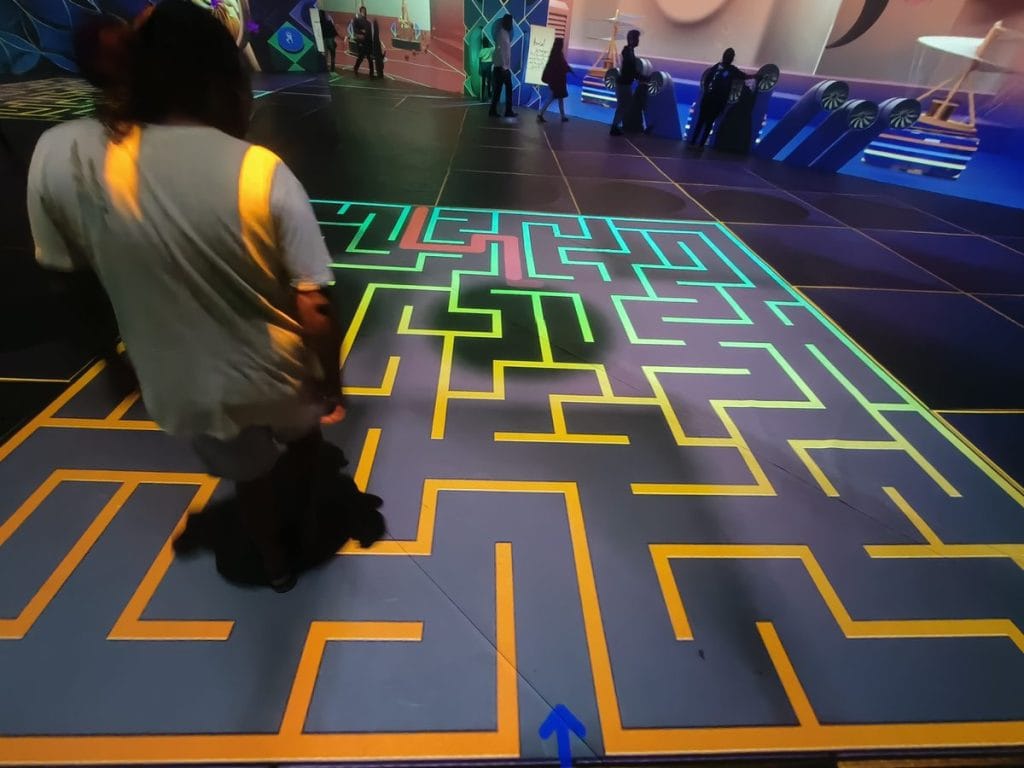
According to him, the play-way interactions at Da Vinci verged on “childish” at times. At times, the spectacle overshadows the substance.
“The show is quite dumbed down to add entertaining elements. However, there were moments where I learnt something new about Da Vinci—the perspective that he used in The Last Supper and the flying wings (ornithopters). The music score was stellar,” he added.
Also Read: What’s missing in the new Humayun Museum of Mughal history? A key decade of India
Technology and theatre
Da Vinci Genius is a feat of storytelling, technology, and scale.
“The length of walls is 24,900 millimetres, while the width of the wall is 16,000 millimetres and doors are 1,800 millimetres, making it the largest immersive room India has ever seen. The precision is maintained in the show calibration,” said Tabish F Khan, founder and director of Theia Enterprise.
For the interactive element, Da Vinci Genius combines LiDAR (light detection and ranging) for motion tracking with touch-responsive walls that trigger animations.
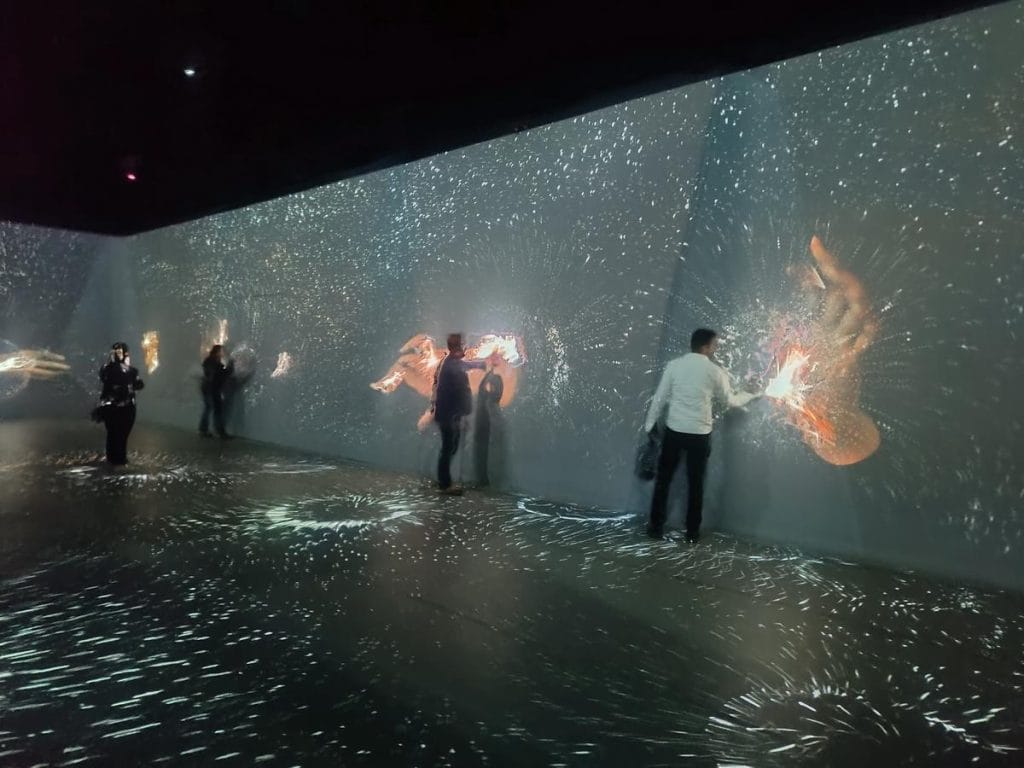
“When one places a hand on the wall, it identifies the size of the object touching it and relays a message to the stage precision servers used for data synchronisation. They, in turn, pass it to the Disguise servers that create pixel perfect visuals. These create animation around the motion, triggering the relevant immersive sound. All this happens in nanoseconds, for 100 people gathered in the show,” Khan added.
However, for Pune-based multimedia artist Gaurav Ogale, immersive art is not just about tech and optics, but how an experience lingers.
“Immersive art should not just touch your five senses but also leave an afterthought. It must generate a response, which could be instant or ignites curiosity later,” he said.
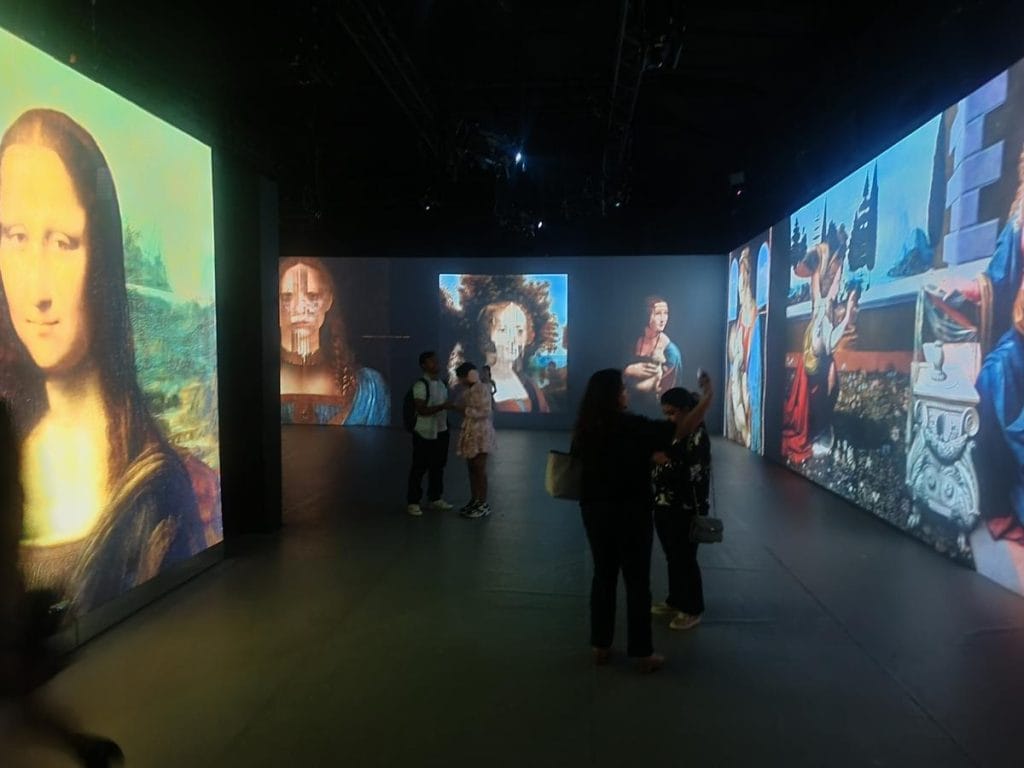
Where the exhibition succeeds, he noted, is in entertaining and engaging people.
“A show on Da Vinci works because he is known. Bringing in artists with wider public recognition helps make such experiences relevant,” Ogale said.
But with visitors constantly pulling out their phones to document the exhibition, he questioned how much it actually immersed them in the moment.
“One could document it beautifully, take a nice video or tell somebody about it, but to me, that is sort of diluting the experience, “ he said.
(Edited by Asavari Singh)



